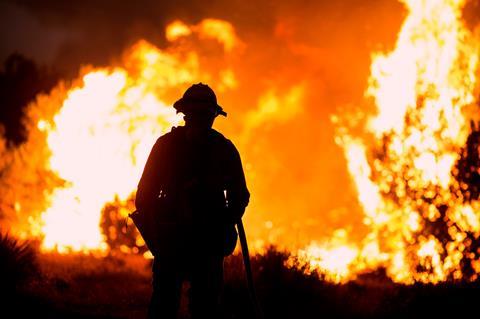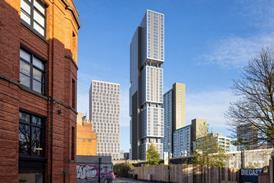Wildfires, hurricanes, and rising sea levels have made no corner of the US immune to the impacts of climate change, but political divisions and fragmented policies continue to hinder progress. While some states lead with bold initiatives – from flood defences to Passive House standards – the lack of a unified national strategy raises urgent questions about how much more destruction the nation can withstand before meaningful action is taken, writes Chris Fogarty

2024 was a tough year for the US when it came to climate-related disasters, and already, with the recent wildfires in Los Angeles, 2025 is off to a terrible start. Hurricanes alone took nearly 300 lives and caused over $200 billion in damages last year. Hurricane Helene slammed into west Florida, but its impact reached far inland, even hitting places once considered “climate havens”, like Asheville, North Carolina.
Our practice has projects in flood-prone areas of Florida, as well as in New York and New Jersey. As in the UK, local building and zoning rules require residential projects to be at least one foot above the “1-in-100-year” flood level – a flood with a 1% chance of happening each year. This often means designing buildings with their main entrance five to six feet above street level and ensuring that the entire structure is also wet- or dry-flood-proofed to that height.
Flood resilience, though, isn’t just about individual buildings. In Hoboken, New Jersey – a city hit hard by Superstorm Sandy – a $400 million flood wall was recently completed. Across the river, New York City is working on the ambitious “Big U” project. Designed by BIG Architects and One Architecture, this $2.7 billion, ten-mile-long flood barrier aims to protect lower Manhattan from future storm surges.
About 80% of Americans live along the coasts, where rising sea levels and flooding are clear signs of global warming. But, as the destruction in Asheville showed, no part of the US is safe from climate change. From wildfires and hurricanes to tornadoes and heavy rainfall, disasters are affecting the entire country.

With these events’ growing frequency and cost, you’d think Americans would rally around tackling climate change. However, political divisions have made a unified national strategy nearly impossible. Federal climate policies swing dramatically with leadership changes. For example, the earlier Trump administration pulled out of the Paris Agreement, only for the Biden administration to rejoin it. Biden also passed the Infrastructure and Inflation Reduction Acts that set the path for the US to achieve net zero by 2050. Trump has promised to exit the Paris Agreement and roll back those new green policies while ramping up oil and gas production under the slogan “drill, baby, drill”.
The UK has kept a fairly consistent approach to climate policy. While different governments might tweak the goals a bit, there’s a general agreement on the need for action. This unified strategy has raised public awareness, with many Brits now conscious of their personal carbon footprints. In contrast, the US is still far behind. Even with the latest version of LEED focusing more on embodied carbon, debates like the one in London over the future of the Marks & Spencer building on Oxford Street are unlikely to occur in the US anytime soon.
With no unified national policy, state and local governments are leading the charge on green initiatives. States like California, which has an economy larger than the UK’s, have an outsized influence. When California enacts stricter automotive efficiency standards, car manufacturers are often forced to adopt them nationwide.
We truly need a cultural and political shift here in the US that prioritises climate awareness and compels our political leaders to take bold, unified action
While transportation contributes significantly to CO₂ emissions, the built environment plays an even more significant role. Operating residential and commercial buildings accounts for nearly 30% of the U.S.’s annual emissions, with construction adding another 10%.
Some states are stepping up to the challenge. New York recently became the first state to ban fossil fuels in new buildings, eliminating gas and oil boilers and all gas appliances. New York City has introduced zoning incentives, like extra floor area for fully electrified buildings that exceed energy code standards. Many state and city-funded projects now require compliance with Passive House standards for new construction.
Nationally, most sustainable energy requirements that used to be optional under LEED certification are now mandatory under updated International Building Code (IBC) standards. States like California, Massachusetts, New York, and Vermont have gone further with even stricter energy-efficient “stretch” codes.
These efforts are promising, but they’re still woefully fragmented. As a global leader, the US cannot afford to move forward without a clear, coordinated strategy to address climate change. It raises the question: how much worse does the damage need to get before the public demands action from their politicians? Education and others leading by example are essential steps, but consistent shared political leadership matters even more.
Architects, as critical players in shaping the built world around us, have a responsibility to push sustainable design and contribute to the development of innovative techniques and strategies. However, large-scale environmental progress and change can only happen with policy changes at a national and international level. We truly need a cultural and political shift here in the US that prioritises climate awareness and compels our political leaders to take bold, unified action.
> Also read: Want to know about Net Zero? Take a short hard look
Postscript
Chris Fogarty is co-founding principal of Fogarty Finger.
















1 Readers' comment